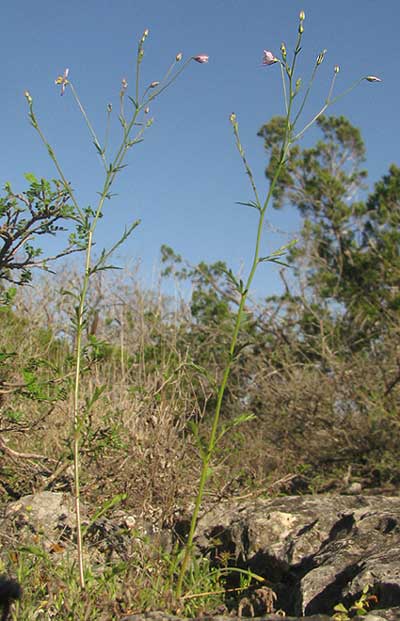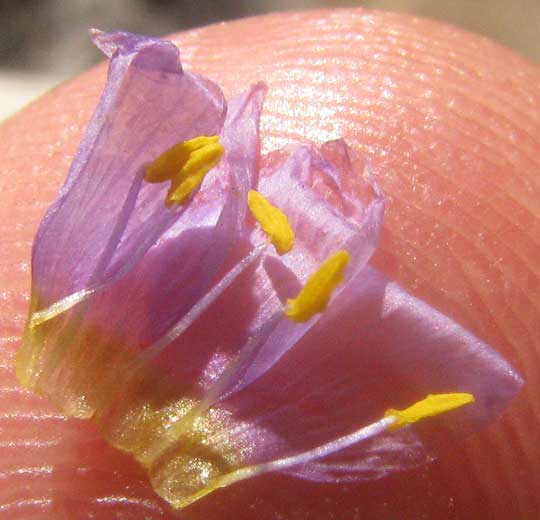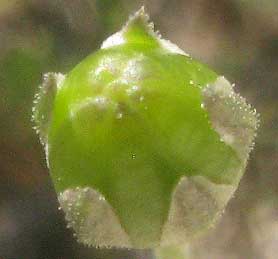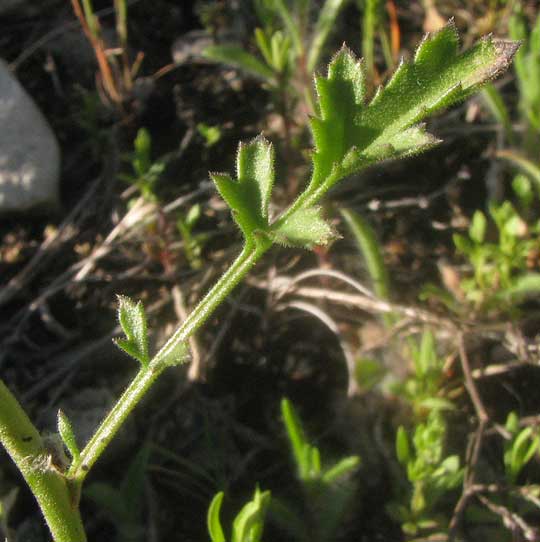Excerpts from Jim Conrad's
Naturalist Newsletter
from the April 13, 2014 Newsletter issued from the Frio Canyon Nature Education Center in the valley of the Dry Frio River in northern Uvalde County, southwestern Texas, on the southern border of the Edwards Plateau; elevation ~1750m (~5750 ft); N29.62°, W99.86°; USA
SPLIT-LEAF GILIA
A good place to look for rare plants is on very thin soil atop bedrock. Such soil typically is so dry and features such a high or low pH that only plants specially adapted to such conditions can survive in it. That's why I make a point of regularly visiting the top of our hill such soil accumulates in patches atop hard Edwards Limestone bedrock. Below, you can see one of the hilltop's tub-size depressions where some highly calcareous soil has gathered:

This week the little depression hosts the pink-blossomed, foot-tall wildflower shown below:

I'd never seen anything like this. For one thing, the flowering head, or inflorescence, is curious, the individual flowers on crooked necks atop very long stalks, or pedicels, the pedicels seeming to issue from where small bracts or modified leaves attach to the stems. This is not the normal spike, raceme or panicle configuration of most inflorescences.
Also, up close, the flowers, only about a third of an inch across (8mm), at first glance appeared very typical, with five sepals, five petals, five stamens, and a spherical, superior ovary topped with a style with three stigmas, as shown below:

The first noteworthy feature was that the corolla comes off in one piece -- so the petals are attached to one another at their bases -- which is important to notice because the petals of many species are completely separate from one another and fall off one at a time. Also, the stamens, instead of arising separately from beneath the ovary, are attached to the corolla's short tube. A dissected corolla showing all this is shown below:

 Such a configuration, though important to notice, isn't rare. However, the ovary left when the corolla fell off was more interesting. One is shown nestled in its calyx at the right.
Such a configuration, though important to notice, isn't rare. However, the ovary left when the corolla fell off was more interesting. One is shown nestled in its calyx at the right.
Ovaries typical for this kind of 5-5-5 blossom are partitioned inside with five or no pie-slice-shaped sections, or carpels. This ovary has three, which is hard to determine unless you study it closely. Notice the three fissures converging at the ovary's top.
At this point it seemed that our plant might belong to a handful of families, especially maybe the Primrose Family. But then I noticed the leaves, one of which is shown below:

Such a pinnately divided leaf with leaflets bearing sharp teeth just don't belong on any plant in the plant families I'm familiar with. This plant turned out to be hard to identify. However, in the end, by noting such technical features as how the ovules were arranged inside the ovary, the little beauty's name was revealed.
It's the Split-leaf Gilia, GILIASTRUM INCISUM, a member of the Phlox Family, the Polemoniaceae. I thought I knew the Phlox Family, for we all know what phlox look like, but now it's apparent that the family is more diverse than I thought. The "Gilia" in our plant's name comes from the plant's history of being assigned to the genus Gilia, before it was shifted to Giliastrum. The genus Gilia was named for a Spanish botanist of the late 1700s.
Is this a rare plant? Not terribly so, though it's certainly not a weed. It's found mostly in rocky and gravelly areas with silty or sandy soils, and is distributed mostly in arid northern Mexico, extending into the US only as far as southern Texas and southeastern New Mexico.
Even though it's not particularly rare, in such an austere, sun-baked, wind-swept environment as the thin soil atop our limestone hill, it's good to see the fragile little Split-leaf Gilia seeming very much at home.